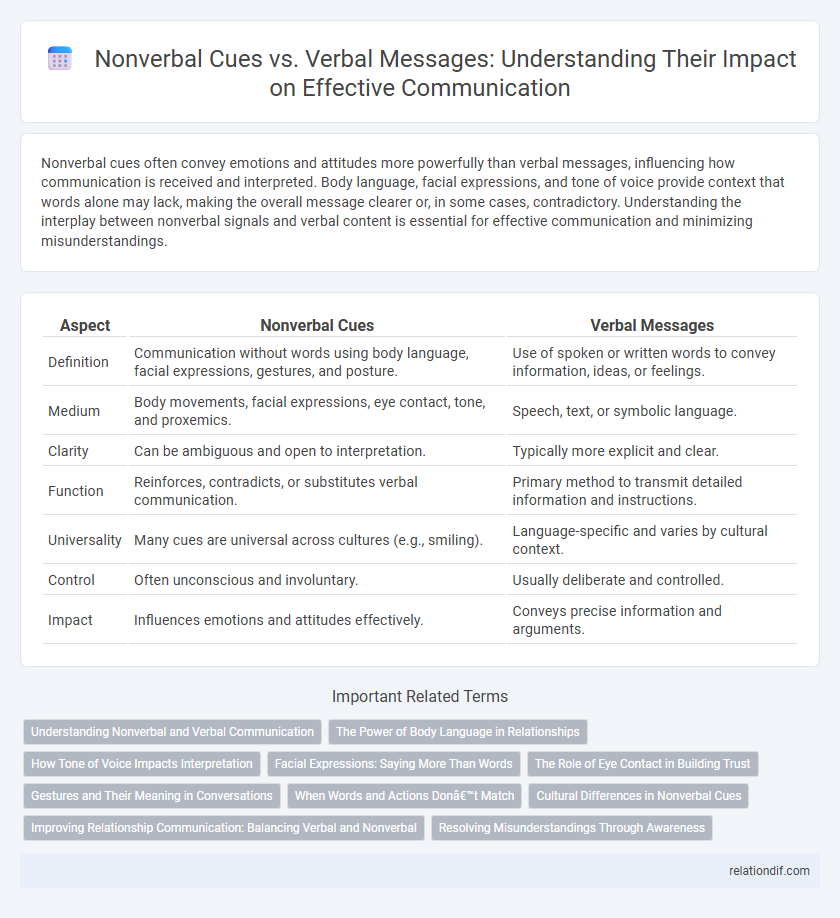Nonverbal cues often convey emotions and attitudes more powerfully than verbal messages, influencing how communication is received and interpreted. Body language, facial expressions, and tone of voice provide context that words alone may lack, making the overall message clearer or, in some cases, contradictory. Understanding the interplay between nonverbal signals and verbal content is essential for effective communication and minimizing misunderstandings.
Table of Comparison
| Aspect | Nonverbal Cues | Verbal Messages |
|---|---|---|
| Definition | Communication without words using body language, facial expressions, gestures, and posture. | Use of spoken or written words to convey information, ideas, or feelings. |
| Medium | Body movements, facial expressions, eye contact, tone, and proxemics. | Speech, text, or symbolic language. |
| Clarity | Can be ambiguous and open to interpretation. | Typically more explicit and clear. |
| Function | Reinforces, contradicts, or substitutes verbal communication. | Primary method to transmit detailed information and instructions. |
| Universality | Many cues are universal across cultures (e.g., smiling). | Language-specific and varies by cultural context. |
| Control | Often unconscious and involuntary. | Usually deliberate and controlled. |
| Impact | Influences emotions and attitudes effectively. | Conveys precise information and arguments. |
Understanding Nonverbal and Verbal Communication
Nonverbal cues such as facial expressions, gestures, and posture convey emotions and intentions that words alone often cannot express. Verbal messages deliver explicit content and information through spoken or written language, requiring clarity and structure to be effective. Understanding the interplay between nonverbal signals and verbal communication enhances message interpretation and reduces misunderstandings.
The Power of Body Language in Relationships
Body language conveys emotions and intentions more powerfully than words, often revealing true feelings in relationships. Nonverbal cues such as eye contact, facial expressions, and posture enhance understanding and trust between partners. Misalignment between verbal messages and body language can create confusion, highlighting the importance of consistent nonverbal communication.
How Tone of Voice Impacts Interpretation
Tone of voice significantly influences the interpretation of verbal messages by conveying emotions such as sincerity, anger, or sarcasm beyond the words spoken. Nonverbal cues like pitch, volume, and pace provide critical context that can alter the meaning and perceived intent of a message. Understanding tone enhances communication effectiveness by aligning emotional expression with verbal content.
Facial Expressions: Saying More Than Words
Facial expressions convey complex emotions and intentions beyond spoken language, making them a powerful form of nonverbal communication. Studies show that up to 55% of interpersonal communication effectiveness stems from facial cues, which can reveal feelings such as happiness, anger, or confusion instantly. Unlike verbal messages, facial expressions are often universal across cultures, providing a reliable means to interpret true emotions and enhance message clarity.
The Role of Eye Contact in Building Trust
Eye contact serves as a powerful nonverbal cue that significantly influences trust-building in communication by signaling attentiveness and sincerity. Studies show that maintaining appropriate eye contact can enhance perceived credibility and emotional connection between interlocutors. Verbal messages combined with consistent eye contact create a cohesive communication experience that fosters deeper interpersonal trust.
Gestures and Their Meaning in Conversations
Gestures play a crucial role in communication by complementing or contradicting verbal messages, often conveying emotions and intentions more accurately than words alone. Hand movements, facial expressions, and body posture can indicate agreement, confusion, or hostility, influencing the overall interpretation of the conversation. Understanding cultural differences in gestures is essential for effective communication, as the same gesture may have varying meanings across different societies.
When Words and Actions Don’t Match
Nonverbal cues often reveal true feelings when verbal messages contradict them, as body language, facial expressions, and tone of voice communicate underlying emotions more accurately. Inconsistent signals between spoken words and nonverbal behavior can lead to misunderstandings and diminished trust in personal and professional communication. Effective communication requires awareness of these discrepancies to interpret messages correctly and respond appropriately.
Cultural Differences in Nonverbal Cues
Nonverbal cues vary significantly across cultures, influencing the interpretation of gestures, facial expressions, and body language in communication. For example, eye contact, which signifies confidence and attentiveness in Western cultures, may be perceived as disrespectful or confrontational in some Asian and Middle Eastern societies. Understanding these cultural differences in nonverbal communication is essential for effective intercultural interactions and reducing misunderstandings.
Improving Relationship Communication: Balancing Verbal and Nonverbal
Effective relationship communication requires balancing verbal messages with nonverbal cues to enhance understanding and emotional connection. Nonverbal signals such as body language, facial expressions, and tone of voice often convey feelings more accurately than words alone. Integrating clear verbal communication with consistent nonverbal behavior strengthens trust and minimizes misunderstandings between partners.
Resolving Misunderstandings Through Awareness
Nonverbal cues, such as body language, facial expressions, and tone of voice, often convey emotions and intentions more accurately than verbal messages, which can be ambiguous or misinterpreted. Awareness of these nonverbal signals enhances communication by allowing individuals to detect discrepancies between spoken words and true feelings, facilitating quicker resolution of misunderstandings. Developing skills in interpreting nonverbal communication improves interpersonal relationships and reduces conflicts across both personal and professional settings.
Nonverbal Cues vs Verbal Messages Infographic

 relationdif.com
relationdif.com